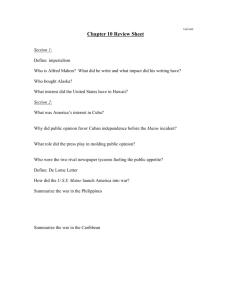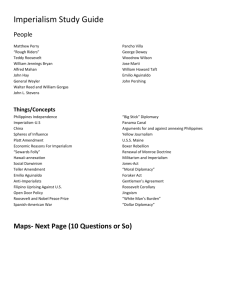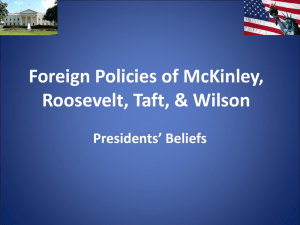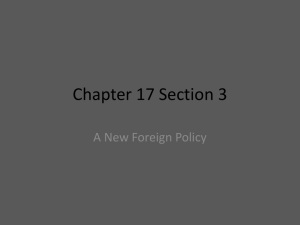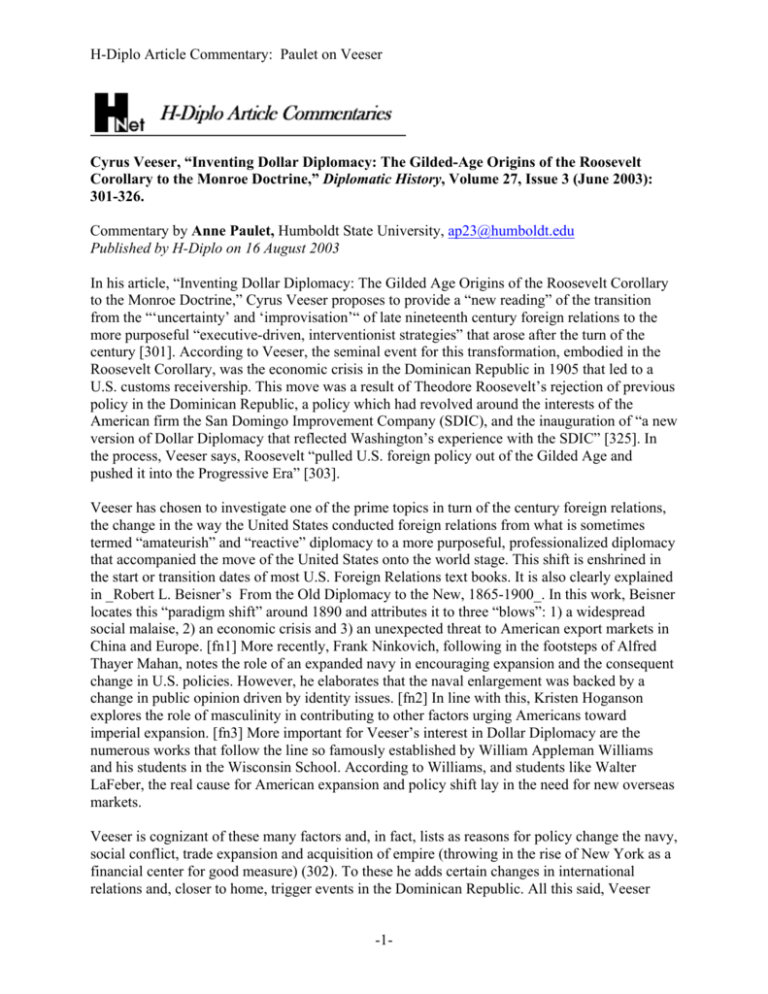
H-Diplo Article Commentary: Paulet on Veeser
Cyrus Veeser, “Inventing Dollar Diplomacy: The Gilded-Age Origins of the Roosevelt
Corollary to the Monroe Doctrine,” Diplomatic History, Volume 27, Issue 3 (June 2003):
301-326.
Commentary by Anne Paulet, Humboldt State University, ap23@humboldt.edu
Published by H-Diplo on 16 August 2003
In his article, “Inventing Dollar Diplomacy: The Gilded Age Origins of the Roosevelt Corollary
to the Monroe Doctrine,” Cyrus Veeser proposes to provide a “new reading” of the transition
from the “‘uncertainty’ and ‘improvisation’“ of late nineteenth century foreign relations to the
more purposeful “executive-driven, interventionist strategies” that arose after the turn of the
century [301]. According to Veeser, the seminal event for this transformation, embodied in the
Roosevelt Corollary, was the economic crisis in the Dominican Republic in 1905 that led to a
U.S. customs receivership. This move was a result of Theodore Roosevelt’s rejection of previous
policy in the Dominican Republic, a policy which had revolved around the interests of the
American firm the San Domingo Improvement Company (SDIC), and the inauguration of “a new
version of Dollar Diplomacy that reflected Washington’s experience with the SDIC” [325]. In
the process, Veeser says, Roosevelt “pulled U.S. foreign policy out of the Gilded Age and
pushed it into the Progressive Era” [303].
Veeser has chosen to investigate one of the prime topics in turn of the century foreign relations,
the change in the way the United States conducted foreign relations from what is sometimes
termed “amateurish” and “reactive” diplomacy to a more purposeful, professionalized diplomacy
that accompanied the move of the United States onto the world stage. This shift is enshrined in
the start or transition dates of most U.S. Foreign Relations text books. It is also clearly explained
in _Robert L. Beisner’s From the Old Diplomacy to the New, 1865-1900_. In this work, Beisner
locates this “paradigm shift” around 1890 and attributes it to three “blows”: 1) a widespread
social malaise, 2) an economic crisis and 3) an unexpected threat to American export markets in
China and Europe. [fn1] More recently, Frank Ninkovich, following in the footsteps of Alfred
Thayer Mahan, notes the role of an expanded navy in encouraging expansion and the consequent
change in U.S. policies. However, he elaborates that the naval enlargement was backed by a
change in public opinion driven by identity issues. [fn2] In line with this, Kristen Hoganson
explores the role of masculinity in contributing to other factors urging Americans toward
imperial expansion. [fn3] More important for Veeser’s interest in Dollar Diplomacy are the
numerous works that follow the line so famously established by William Appleman Williams
and his students in the Wisconsin School. According to Williams, and students like Walter
LaFeber, the real cause for American expansion and policy shift lay in the need for new overseas
markets.
Veeser is cognizant of these many factors and, in fact, lists as reasons for policy change the navy,
social conflict, trade expansion and acquisition of empire (throwing in the rise of New York as a
financial center for good measure) (302). To these he adds certain changes in international
relations and, closer to home, trigger events in the Dominican Republic. All this said, Veeser
-1-
H-Diplo Article Commentary: Paulet on Veeser
believes that the specifics of the Dominican crisis and especially the role played by the SDIC
have been overlooked. In studying the role of this company in greater detail, he seeks to prove
that the events in the Dominican Republic mark a clear move from one era to another and that
the basis of Dollar Diplomacy, most commonly associated with the lawyerly Taft not the activist
Roosevelt, actually coalesced in form and function under the latter. It is an ambitious task, and
certainly Veeser is to be applauded for including research in the Dominican archives in his study
of U.S. policy. Yet, although Veeser is ambitious, interesting and perhaps even correct, the
structure of his article does not clearly support his contentions.
To begin, there is definitional fuzziness. The article is called “Inventing Dollar Diplomacy” but
what dollar diplomacy is, is never really discussed. In a footnote on the first page Veeser
compliments Emily Rosenberg on how she uses an “apparently narrow definition” to expand on
other topics [301] yet he never states how he defines it. Not until the conclusion does Veeser
really discuss the elements of dollar diplomacy which he says were forged during the Dominican
crisis [325]. The issue of definition seems especially important since, as noted above, Veeser
states that the Dominican crisis marked the advent of a new version of Dollar Diplomacy.
Indeed, he claims that there was movement from “the disastrous attempt to practice Dollar
Diplomacy through the SDIC” to a “new Progressive version” though neither is made clear prior
to the very end [323]. On the last page, Veeser finally defines the SDIC as a “small-scale, closely
held, capital-poor, politically oriented firm” [326] which is obviously intended to set it apart
from the major investment banks mentioned on page 323 as part of the new configuration and
policy. This definitional issue extends to another major claim made in the introduction, that of
the movement from the Gilded Age to the Progressive Era. To clearly illustrate such movement,
it would be necessary to establish the traits of each, at least in connection with the issue at hand,
in order to show the shift from one to the other. However, that is never directly done and only
drawn out by inference at the end.
In addition to definition difficulties, there appear to be relational ones as well. Veeser claims that
the SDIC served as a negative example to Roosevelt of what not to do. Yet for most of the
article, John Bassett Moore, the SDIC legal counsel and State Department appointed
representative for the arbitration hearings, is dealing with the State Department and not directly
with the president. Veeser talks about how the State Department was willing to allow Moore to
act in a dual capacity [307] and how they stood by Moore despite concerns of the American
Consul in the Dominican Republic [311]. On the following page, Veeser does say that Moore’s
ability to convince the State Department that all was well would lead to Roosevelt’s intervention
and mentions that in November 1904, Moore went directly to the president about naval support
[312]. The appearance, finally, of the very person that Moore and the SDIC are supposed to be
influencing, however, only muddies rather than clears things.
Moore is supposedly in close contact with the president over the next few months, even meeting
with him twice in January 1905 and adding an entire paragraph to the speech that accompanies
the Dominican Protocol to the Senate in February. It is this speech, presaged in the December
1904 annual message to Congress, that is considered the Roosevelt Corollary-the major change
in policy Veeser is focusing on and that the poor actions of the SDIC are supposed to have
influenced. At the same time, Veeser notes that in December 1904 “although the likelihood of
European intervention is not certain, European pressure did move Roosevelt to revise the policy
-2-
H-Diplo Article Commentary: Paulet on Veeser
of unconditional support for the Improvement Company” [314]. Here’s the problem; the actions
of the SDIC are supposed to be influencing the change in policy that emerges in February 1905-a
policy that is antithetical to what the SDIC wants, yet Moore, the SDIC representative, is still
close enough to Roosevelt to add paragraphs. Moreover, this policy had been previewed in
December, after which Roosevelt had continued to meet with Moore. Most importantly, this
major switch, supposedly caused by SDIC behavior and European pressure at the end of 1904, is
actually first sketched out by Roosevelt “as early as 20 May 1904,” according to a footnote on
page 317, long before the arbiters had ruled in favor of the SDIC in July and before the State
Department had “stood by Moore and the SDIC through the fall of 1904” [311]. As a result, the
causal relationship Veeser is trying to establish simply does not seem to work properly.
Clearly, Veeser shows there is a break between the SDIC and the goals of the administration, and
the fact the SDIC was not in better control in the Dominican Republic and had distressed
European countries had some bearing on the distancing of Washington. It is also true that the
SDIC, as finally explained, was an older type of company while the investment banks
championed under the new policy were part of the growing corporate order. All that said I
remain unconvinced, as the article and proof are presently structured, that they had the direct
causal relation Veeser says. Why, after all, in May 1904, was Roosevelt already thinking along
the lines of the Roosevelt Corollary before there even was a major crisis, before Moore was
writing memorandum for Secretary of State Hay or having conferences with Roosevelt, before, it
would seem, the SDIC was much of a factor on anyone’s radar? It may be that the Dominican
crisis and the SDIC handling of it, especially their tendency to dismiss European claims, created
the climate for Roosevelt to issue a change in policy; a much more direct relationship than that
remains questionable.
Anne Paulet
NOTES
[FN1] Robert L. Beisner, _From the Old Diplomacy to the New, 1865-1900, Second Edition_
(Arlington Heights, IL: Harland Davidson Inc., 1986), 72-74.
[FN2] Frank Ninkovich, _The United States and Imperialism_, (Malden, MA: Blackwell
Publishers, 2001) see especially Chapter 1, 9-47.
[FN3] Kristen L. Hoganson, _Fighting for American Manhood: How Gender Politics Provoked
the Spanish-American and Philippine-American Wars_, (New Haven: Yale University Press,
1998).
Copyright © 2003-2004 by H-Diplo, all rights reserved. H-Net permits the redistribution and
reprinting of this work for nonprofit, educational purposes, with full and accurate attribution to
the author, web location, date of publication, originating list, and H-Net: Humanities & Social
Sciences Online. For other uses contact the H-Diplo Article Discussion Co-ordinator, George
Fujii, gfujii@umail.ucsb.edu.
-3-


